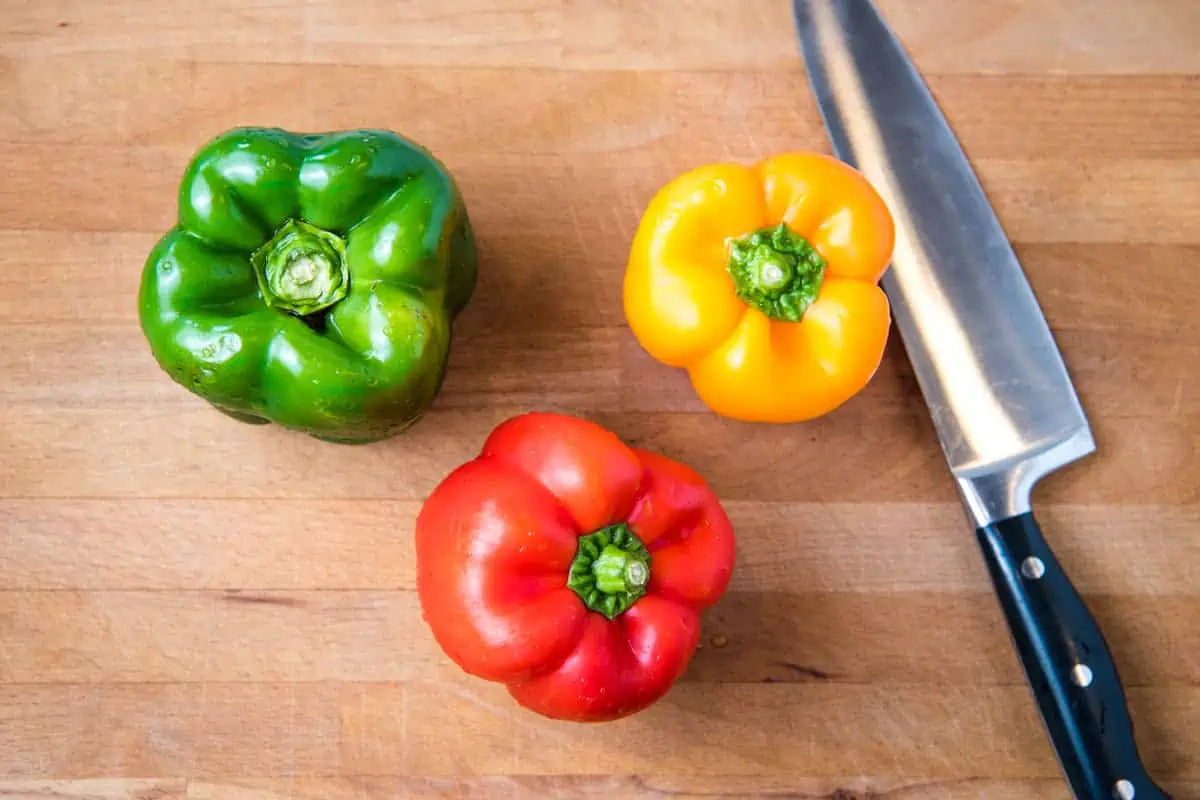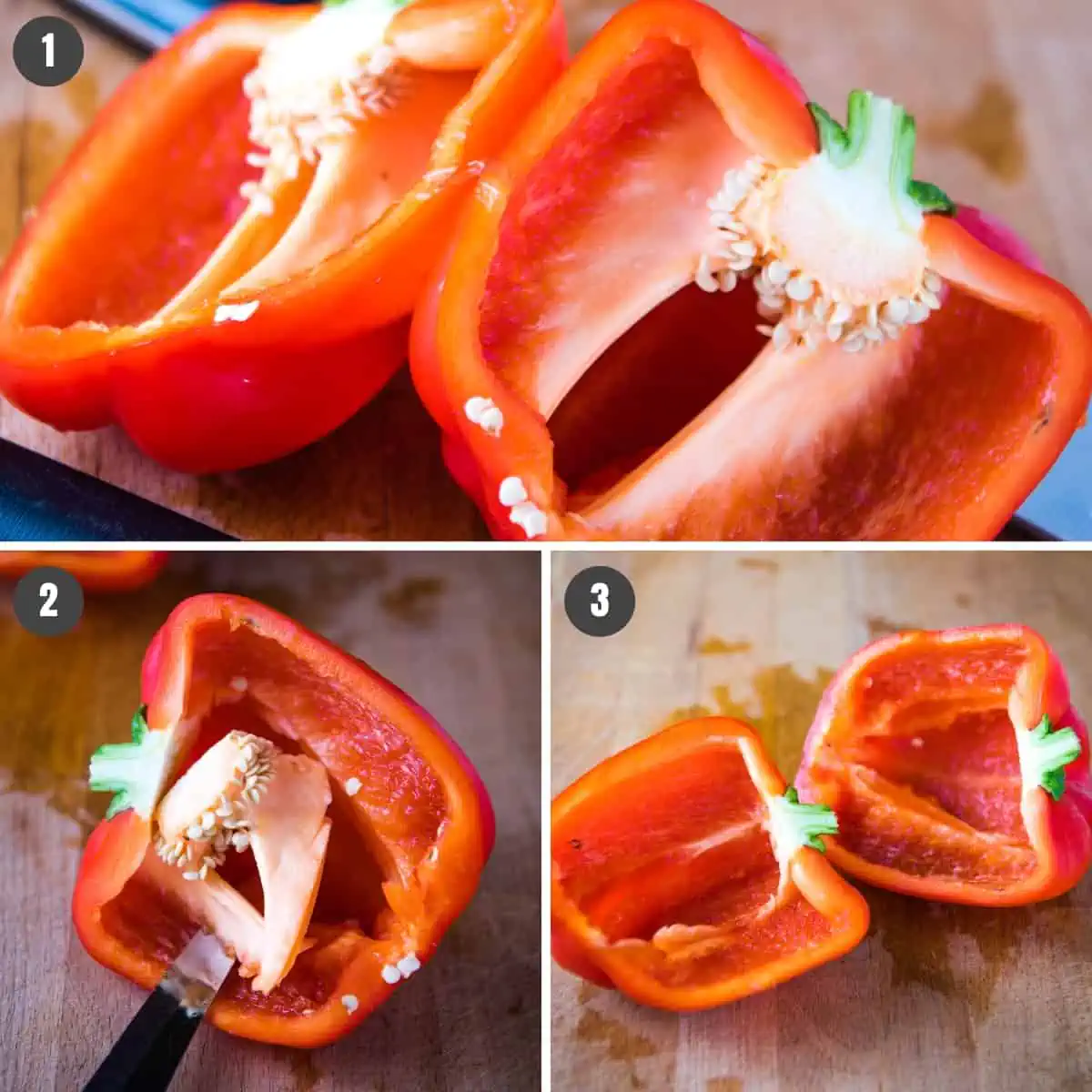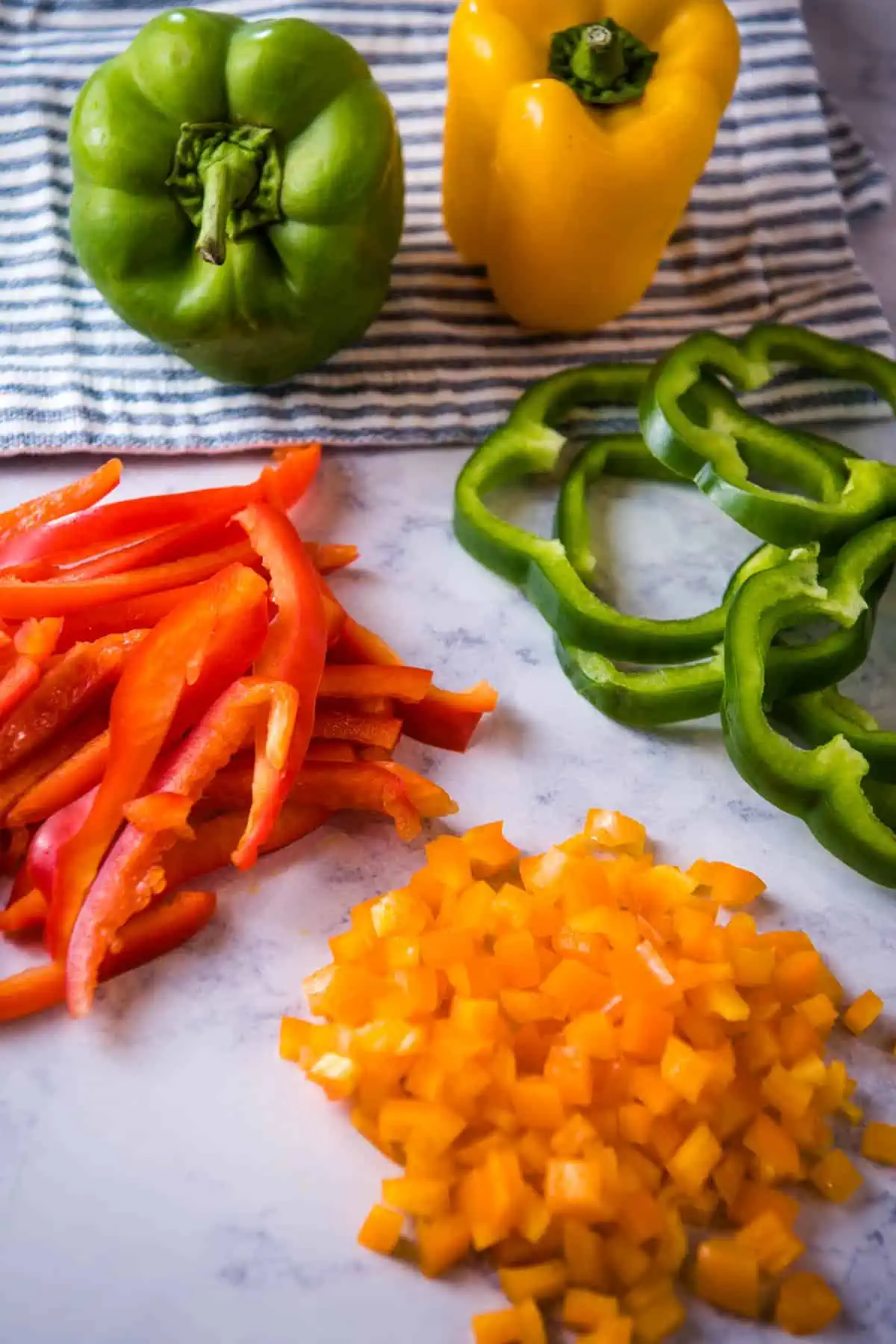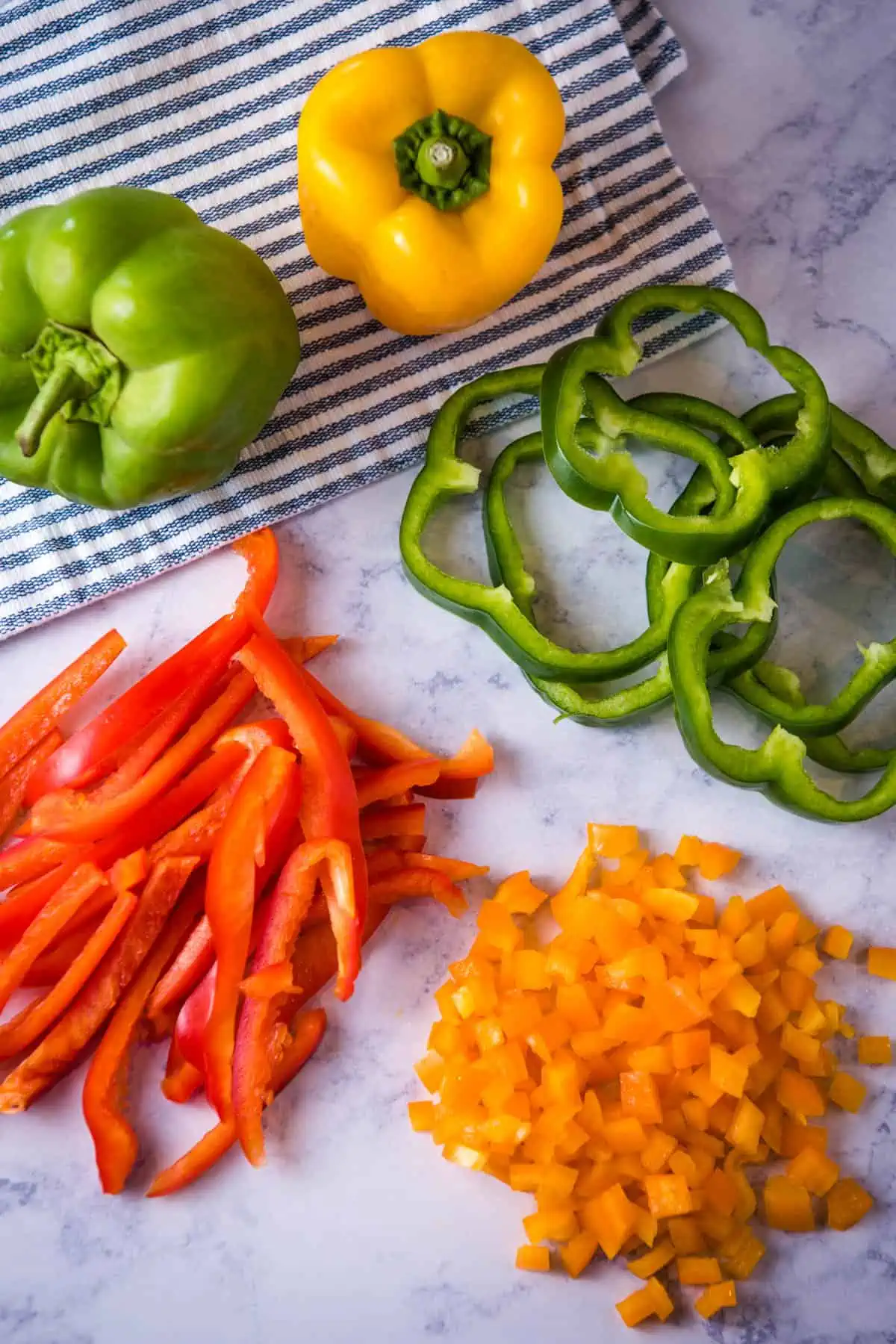Learn how to cut a pepper 4 easy ways, into halves, rings, sliced or julienned, and diced. Tips and hacks, along with a variety of delicious, flavorful recipe ideas you can make.
I love a good bell pepper. Why, you ask? Mainly because of the flavor they give, but there are a few reasons to love bell peppers…
- Bell peppers give so much flavor to so many dishes.
- They also make food pretty. They give bright, vibrant color to whatever dish you happen to be cooking.
- They're crispy crunchy. Even when they're cooked, they still have a slightly crisp texture.
- They're healthy and full of nutritional benefits like vitamin A, vitamin B6, vitamin C, vitamin E, vitamin K1, folate, potassium, fiber, and antioxidants.
- They're delicious both raw and cooked.
What Are Bell Peppers?
Did you know that bell peppers are actually fruit? I was under the assumption they're vegetables, but they're actually classified as fruits. They belong to the nightshade family, which is why some people can have a harder time digesting them, or they can have symptoms from consuming them. (But that's a whole other discussion.)
You'll find bell peppers in various colors. Readily available in grocery stores, you'll find red, yellow, orange, and green. If you grow them yourself, you know you can also add colors like purple and chocolate to the mix.
Other Types of Peppers
While I'm mainly showing how to cut a bell pepper in this post, there are other types of peppers like chili peppers, cayenne peppers, jalepeños, pepperoncini, pimento, etc. The list goes on and on.

How to Pick Good Bell Peppers
While I love to grow our own bell peppers, I do buy peppers from the store, as well. There are a few things I look for when picking the best bell peppers possible…
- Color – Is the pepper a bright, shiny color? Or is it dull and discolored in spots? Look for that bright, shiny, vibrant, all one color pepper.
- Texture – Is it firm, or is it wrinkly? You don't want wrinkly because that signals the pepper's been sitting there awhile and is rather old.
- Weight – Is it lightweight, or is it firm? You'll get a better pepper, the heavier it is.
- Shape – Ok, my friend Kelly from EatPicks has taught me that a pepper with 4 lobes (look at the bottom of the pepper for the lobes) is a sweeter pepper. One with 3 lobes won't be quite as sweet. So I always take that shape factor into account. Plus, when I'm making stuffed peppers, I really like the pepper to be able to stand on its own if I'm not cutting it into halves.
What's the Difference Between Green, Yellow, Red, and Orange Bell Peppers?
Actually, they're nutritionally different and can have different flavors.
- Green and red bell peppers have more vitamin C, in fact, according to Mississippi State University Extension, they have 2-3 more times vitamin C than an actual orange.
- The longer the pepper is on the plant, the more nutrient dense it will be. Green peppers are picked first, so they're less nutrient dense than red, yellow, or orange. Red are on the vine the longest, so they're packed with the most nutrients. And as they ripen, the cancer-fighting antioxidants they contain change, as well.
- The longer they ripen, the sweeter they become, as well… So, in other words, a green bell pepper won't be as sweet as a red; red bell peppers are the sweetest.
How to Cut a Pepper
There are 4 specific ways you can learn how to cut bell peppers. But first let's talk tips and tricks for making the process easier and more efficient.
Tips and Tricks to Consider Before Starting
First of all, be sure to remove any stickers, and wash the peppers before cutting into them. I recommend using either home grown or organic peppers, mainly because bell peppers are on the Dirty Dozen list.
The main tip I can give you is to use a butcher block cutting board, and make sure your knife is sharp. I usually use a chef's knife, along with a long paring knife for cutting out the core. We regularly sharpen our knives, so they give the best cut with the least amount of resistance. Believe it or not, a dull knife can lead to injury faster than a sharp knife.
Also, when cutting apart the peppers, save back the stems and core. If you have chickens, they'll love it. If not, add them to your compost bin or pile. You can even use the stem when making homemade vegetable stock.
Option #1: How to Cut a Pepper into Halves
- Slice the pepper in half length wise, making a clean cut through with your knife.
- Use a long paring knife to slice under and around the core of the pepper, removing the core and all seeds from the pepper. (Sometimes I go the easier route and just pull the core and seeds out with my fingers. Whatever works easiest.)
- You can leave the stems intact, or you can remove them at this point. If making stuffed peppers, they really add to the dish and make the peppers pretty… Just a thought.

Option #2: How to Cut Peppers into Rings
- First, cut the top end of the pepper off.
- Use a long paring knife to go down into the pepper and slice under and around the core of the pepper, removing the core and all seeds from the pepper.
- Then slice the hollowed out pepper into 1/8 to 1/4-inch rings.
- Discard the bottom of the pepper, and you'll have a small pile of pepper rings for a beautiful veggie platter or salad.

Option #3: How to Slice (or Julienne) Peppers
- Cut the pepper into halves, as shown above.
- Then spread the pepper out, smashing it down with your hands, skin side down so it's easier to slice.
- Use a chef's knife to slice the smashed halves into slices or thinner julienned strips.
- You'll have a handful of pepper strips you can use for fajitas, in stir fry, enjoy as a snack, and more.

Option #4: How to Dice Bell Peppers
- Make the choice to either cut the pepper into halves, as shown above. Or you can leave the pepper whole and cut out the core.
- Remove the core and seeds from the inside of the pepper.
- Once cored, if not halved, cut the pepper into halves, then strips (again, as instructed above) for dicing.
- Dice the strips, a small handful at a time, starting at one end of the strips and moving to the other end, 'til you have a handful of diced or chopped peppers.

Tip: If you want smaller, minced peppers, when cutting the pepper into strips, cut it into thinner julienned strips. Then dice. If needed, you can mince the smaller diced pieces into smaller pieces.
Expert Tips and Recipe FAQ's
Some recipes may call for this, but for most recipes, you want to leave the peeling intact because it adds to the texture and flavor of the dish. However… There are certain dishes where peeling the skin off the pepper can take that tougher texture away and can give a sweeter flavor to the finished dish. It really just depends on the recipe. For the purpose of preserving bell peppers, you'd leave the skin intact.
The seeds are not only tough, but they can give a more bitter flavor to whatever you're making. They'll take away from the sweet flavor of the peppers.
Yes, you can freeze pepper strips, sliced, or diced peppers. You'll need to flash freeze them on a baking sheet or tray. Then put them in an airtight container or freezer bag so they don't get freezer burn. They should keep in the freezer for about 6-8 months. Nebraska has a great article all about how to freeze peppers.
Whole bell peppers will keep for about 2 weeks in the fridge; store them whole in the crisper drawer for best results. If storing cut peppers, store them with a paper towel in an airtight container or storage bag in the fridge. They should keep for 3-4 days.

My Favorite Recipes with Bell Peppers
Looking for ways to use bell peppers? Here are a few delicious dishes you can make…
Stuffed Peppers –
- Chicken stuffed peppers with spinach
- Philly cheesesteak stuffed peppers
- Taco stuffed peppers
- Sloppy joe stuffed peppers
- Chicken and rice stuffed peppers
Main Dish Dinner Ideas –
- Mexican meat pie
- Crab enchiladas
- Philly cheesesteak – Sliders, Philly cheesesteak sloppy joes, Crock Pot Philly cheesesteak, and original Philly cheesesteak sandwich
- Cheesy turkey casserole
- Instant Pot taco chicken
- Taco tater tot casserole
- Ground beef tacos
Soups and Stews –
Breakfast Recipes –
Sauces and Condiments –
If you try this recipe, why not leave a star rating in the recipe card right below and/or a review in the comment section further down the page? I always appreciate your feedback. You can also follow me on Pinterest, Facebook, Instagram, and YouTube. And subscribe to my email list too!

How to Cut a Pepper
Ingredients
- 1 large green bell pepper
- 1 large red bell pepper
- 1 large yellow bell pepper
- 1 large orange bell pepper
Instructions
- Remove any stickers, and wash the peppers before cutting into them.
How to Cut Peppers into Halves:
- Slice the pepper in half length wise, making a clean cut through with your knife.
- Use a long paring knife to slice under and around the core of the pepper, removing the core and all seeds from the pepper. (Sometimes I go the easier route and just pull the core and seeds out with my fingers. Whatever works easiest.)
- You can leave the stems intact, or you can remove them at this point.
How to Cut Peppers into Rings:
- First, cut the top end of the pepper off.
- Use a long paring knife to go down into the pepper and slice under and around the core of the pepper, removing the core and all seeds from the pepper.
- Then slice the hollowed out pepper into 1/8 to 1/4-inch rings.
- Discard the bottom of the pepper, and you'll have a small pile of pepper rings for a beautiful veggie platter or salad.
How to Slice (or Julienne) Peppers:
- Cut the pepper into halves, as instructed above, and remove the stems.
- Then spread the pepper out, smashing it down with your hands, skin side down so it's easier to slice.
- Use a chef's knife to slice the pepper smashed halves into slices or thinner julienned strips.
- You'll have a handful of pepper strips you can use for fajitas, in stir fry, enjoy as a snack, and more.
How to Dice Bell Peppers:
- Make the choice to either cut the pepper into halves, as shown above; or leave the pepper whole and cut out the core.
- Remove the core and seeds from the inside of the pepper.
- Once cored, if not halved, cut the pepper into halves, then strips (again, as instructed above) for dicing.
- Dice the strips, a small handful at a time, starting at one end of the strips and moving to the other end, 'til you have a handful of diced or chopped peppers.
- Tip: If you want smaller, minced peppers, when cutting the pepper into strips, cut it into thinner julienned strips. Then dice. If needed, you can mince the smaller diced pieces into smaller pieces.







